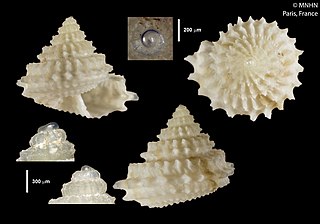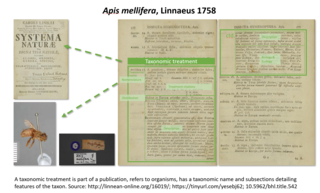
The acrobatic cavy also known as the Acrobatic Moco and Climbing Cavy is a cavy species native to Brazil in the Amazon rainforest. It is found from Goiás state to Tocantins state, west of the Espigão Mestre, Serra Geral de Goiás, and is also found in Terra Ronca State Park.
Plazi is a Swiss-based international non-profit association supporting and promoting the development of persistent and openly accessible digital bio-taxonomic literature. Plazi is cofounder of the Biodiversity Literature Repository and is maintaining this digital taxonomic literature repository at Zenodo to provide access to FAIR data converted from taxonomic publications using the TreatmentBank service, enhances submitted taxonomic treatments by creating a version in the XML format Taxpub, and educates about the importance of maintaining open access to scientific discourse and data. It is a contributor to the evolving e-taxonomy in the field of Biodiversity Informatics.

Calliotropis pyramoeides is a species of sea snail, a marine gastropod mollusk in the family Eucyclidae.
Turbonilla alvheimi is a species of sea snail, a marine gastropod mollusk in the family Pyramidellidae, the pyrams and their allies. The species is named after Oddgeir Alvheim, a senior technician at the EAF-Nansen Programme who studied marine fauna off the coast of Africa.
Glyphidocera Novercae is a pale brownish yellow moth discovered in Costa Rica in 2005 by David Adamski. A member of the Autostichidae family the moth was located at 5 collection sites. G. Novercae differs from Glyphidocera tibiae also discovered by Adamski at similar collection sites. G. tibiae however has an absence of sex scales between abdominal terga 2–3 in the male and other differing attributes.
Glyphidocera tibiae is a moth discovered at two collection sites in Costa Rica in 2005 by David Adamski. With coloring ranging from dark brown on the legs to pale brown hindwing and yellow brown undersurface it is similar to Glyphidocera Novercae also found in Cost Rica around the same time. G. Noverae however has more yellowish features and a more protuberant ventral furca, among other differing features.
Maratus felinus is a species of peacock spider native to Australia. It was discovered at Lake Jasper and Mount Romance along with two other species, Maratus aquilus and Maratus combustus.
Euryarthron festivum is a species of tiger beetle found in western and central Africa. The species was first described by Pierre François Marie Auguste Dejean in 1831. It has been recorded in Senegal, Gambia, Guinea-Bissau, Guinea, Democratic Republic of Congo, Republic of the Congo and Sudan. Festivum is syntopic with Prothyma concinna cursor in many of these countries, and with Ropaloteres cinctus in Guinea-Bissau.

A taxonomic treatment is a section in a scientific publication documenting the features of a related group of organisms or taxa. Treatments have been the building blocks of how data about taxa are provided, ever since the beginning of modern taxonomy by Linnaeus 1753 for plants and 1758 for animals. Each scientifically described taxon has at least one taxonomic treatment. In today’s publishing, a taxonomic treatment tag

Poecilcoris druraei is a species of jewel bug described by Carl Linnaeus in 1771. It is in the family Scutelleridae and is native to Hong Kong, Taiwan, and Thailand.
Betta midas is a species of gourami in the genus Betta. It is native to Asia, specifically the island of Borneo, where it occurs in the Kapuas River basin in West Kalimantan in Indonesia, as well as western Sarawak in Malaysia. It is typically found in acidic blackwater rivers in remnant and intact peat swamp forests. The species reaches 6.6 cm in standard length and is known to be a facultative air-breather.
Quadromalus colombiensis is a species of arachnid found in Colombia.
Ancistrus patronus is a species of catfish in the family Loricariidae. It is native to South America, where it occurs in the Orinoco basin in Venezuela. The species reaches at least 8.6 cm SL and was described in 2019 by Lesley S. de Souza of the Field Museum of Natural History, Donald C. Taphorn of the Royal Ontario Museum, and Jonathan Armbruster of Auburn University alongside five other species of Ancistrus. Its specific name means "defender" in Latin and was given to the species due to the reported tendency of male A. patronus to actively guard their nests and protect their young until they are relatively large.

Nepenthes candalaga is a tropical pitcher plant endemic to Mt. Candalaga, in the Municipality of Maragusan, Davao de Oro, island of Mindanao, Philippines. This bringing the total number of Nepenthes species in this island to 38, making Mindanao the island with the highest concentration of Nepenthes species in the Philippines. Nepenthes candalaga is closely allied to N. justinae but differs in having a lamina with 2 – 3 longitudinal veins that are parallel with the midrib. Additionally, the orbicular lid of the pitchers, the lid spur tip that is non-bifid, the triangular lid appendage, the short banner-shaped wings below the peristome that covers only a sixth of the trap's anterior eventually becoming ridges towards the trap base, and the absent upper pitcher rim that is widest near the peristome differentiates this species from N. justinae. The species is assessed as Critically endangered due to the threats of deforestation and habitat loss without legislative protection.
Edessa virididorsata is a species of stink bug within the family Pentatomidae. It is found in Colombia, Venezuela, Guyana, Surinam, French Guiana, Brazil, Paraguay, and Argentina.
The Mozambique long-fingered bat is a species of bat within the family Miniopteridae. Its distribution is in Africa within countries such as Kenya, Namibia, Ethiopia, Zimbabwe, and other countries in East Africa at elevations of 420 to 1800 meters. It is nocturnal and uses uses caves and mines during the day as roosts. The holotype was collected in a mist net that was placed over a swimming pool at the Bamboo Inn, on the outskirts of Nampula, at an altitude of 420 meters. A paratype was also caught shortly afterwards in the same mist net settup. The species name mossambicus stands for the country the type series was collected in, Mozambique.
Hymenopenaeus fallax is a species of prawn within the family Solenoceridae. The species is found distributed near the Hawaiian Islands at depths of 617 to 1937 meters. Females can grow up to 104 millimeters. Its species name fallax was given due to it often being confused H. obliquirostris.
Anoplognathus olivieri is a species of beetle within the genus Anoplognathus.

Solaster namakae is a species of starfish within the family Solasteridae. The species occurs off the Hawaiian Islands at depths of 1169 to 1979 meters. The species name namakae is named after Nāmaka, the Hawaiian goddess of the ocean. It has eight arms with a thick dermis, covering the starfishes surface. The color of the body can vary from white to dark orange.

Astyanax boliviensis is a small species of fish native to a handful of rivers in northern Bolivia. Its scientific name is an allusion to its range, which includes the Candelaria, Madidi, and Mamoré rivers. Though it lacks a conservation status from the IUCN, a significant portion of its habitat is contained within the Madidi National Park, one of the largest protected regions in the world.






